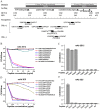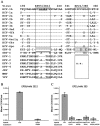Significance of monoclonal antibodies against the conserved epitopes within non-structural protein 3 helicase of hepatitis C virus
- PMID: 23894620
- PMCID: PMC3722154
- DOI: 10.1371/journal.pone.0070214
Significance of monoclonal antibodies against the conserved epitopes within non-structural protein 3 helicase of hepatitis C virus
Abstract
Nonstructural protein 3 (NS3) of hepatitis C virus (HCV), codes for protease and helicase carrying NTPase enzymatic activities, plays a crucial role in viral replication and an ideal target for diagnosis, antiviral therapy and vaccine development. In this study, monoclonal antibodies (mAbs) to NS3 helicase were characterized by epitope mapping and biological function test. A total of 29 monoclonal antibodies were produced to the truncated NS3 helicase of HCV-1b (T1b-rNS3, aa1192-1459). Six mAbs recognized 8/29 16mer peptides, which contributed to identify 5 linear and 1 discontinuous putative epitope sequences. Seven mAbs reacted with HCV-2a JFH-1 infected Huh-7.5.1 cells by immunofluorescent staining, of which 2E12 and 3E5 strongly bound to the exposed linear epitope (1231)PTGSGKSTK(1239) (EP05) or core motif (1373)IPFYGKAI(1380) (EP21), respectively. Five other mAbs recognized semi-conformational or conformational epitopes of HCV helicase. MAb 2E12 binds to epitope EP05 at the ATP binding site of motif I in domain 1, while mAb 3E5 reacts with epitope EP21 close to helicase nucleotide binding region of domain 2. Epitope EP05 is totally conserved and EP21 highly conserved across HCV genotypes. These two epitope peptides reacted strongly with 59-79% chronic and weakly with 30-58% resolved HCV infected blood donors, suggesting that these epitopes were dominant in HCV infection. MAb 2E12 inhibited 50% of unwinding activity of NS3 helicase in vitro. Novel monoclonal antibodies recognize highly conserved epitopes at crucial functional sites within NS3 helicase, which may become important antibodies for diagnosis and antiviral therapy in chronic HCV infection.
Conflict of interest statement
Figures




Similar articles
-
Significance of the immune response to a major, conformational B-cell epitope on the hepatitis C virus NS3 region defined by a human monoclonal antibody.J Virol. 1994 Aug;68(8):4829-36. doi: 10.1128/JVI.68.8.4829-4836.1994. J Virol. 1994. PMID: 7518528 Free PMC article.
-
Characterization of mimotopes mimicking an immunodominant conformational epitope on the hepatitis C virus NS3 helicase.J Med Virol. 2004 Mar;72(3):385-95. doi: 10.1002/jmv.20002. J Med Virol. 2004. PMID: 14748062
-
[Characterization of a panel of monoclonal antibodies to hepatitis C NS3 recombinant protein ].Vopr Virusol. 2002 Jan-Feb;47(1):21-5. Vopr Virusol. 2002. PMID: 11852778 Russian.
-
HCV Helicase: Structure, Function, and Inhibition.In: Tan SL, editor. Hepatitis C Viruses: Genomes and Molecular Biology. Norfolk (UK): Horizon Bioscience; 2006. Chapter 7. In: Tan SL, editor. Hepatitis C Viruses: Genomes and Molecular Biology. Norfolk (UK): Horizon Bioscience; 2006. Chapter 7. PMID: 21250378 Free Books & Documents. Review.
-
Hepatitis C Virus NS3 Helicase Inhibitor Discovery.2011 Dec 16 [updated 2013 Mar 14]. In: Probe Reports from the NIH Molecular Libraries Program [Internet]. Bethesda (MD): National Center for Biotechnology Information (US); 2010–. 2011 Dec 16 [updated 2013 Mar 14]. In: Probe Reports from the NIH Molecular Libraries Program [Internet]. Bethesda (MD): National Center for Biotechnology Information (US); 2010–. PMID: 23762946 Free Books & Documents. Review.
Cited by
-
Identification and expression analysis of antigenic sites of hepatitis C virus genotype 3a NS3 and NS5A genes of local isolate.Egypt Liver J. 2021;11(1):17. doi: 10.1186/s43066-021-00086-8. Epub 2021 Mar 8. Egypt Liver J. 2021. PMID: 34777867 Free PMC article.
-
Characterization of novel Omp31 antigenic epitopes of Brucella melitensis by monoclonal antibodies.BMC Microbiol. 2017 May 15;17(1):115. doi: 10.1186/s12866-017-1025-3. BMC Microbiol. 2017. PMID: 28506316 Free PMC article.
-
Detection of Brucellae in peripheral blood mononuclear cells for monitoring therapeutic efficacy of brucellosis infection.Antimicrob Resist Infect Control. 2019 Oct 15;8:154. doi: 10.1186/s13756-019-0607-2. eCollection 2019. Antimicrob Resist Infect Control. 2019. PMID: 31636897 Free PMC article.
-
Infection of Common Marmosets with GB Virus B Chimeric Virus Encoding the Major Nonstructural Proteins NS2 to NS4A of Hepatitis C Virus.J Virol. 2016 Aug 26;90(18):8198-211. doi: 10.1128/JVI.02653-15. Print 2016 Sep 15. J Virol. 2016. PMID: 27384651 Free PMC article.
References
Publication types
MeSH terms
Substances
LinkOut - more resources
Full Text Sources
Other Literature Sources
Medical
Molecular Biology Databases

